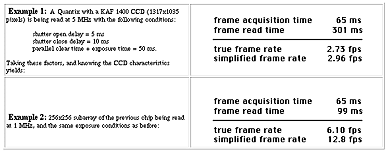Readout vs. Frame Rate
Readout rate is defined as the inverse of the serial conversion time, that is, the time required to digitize a single pixel. Readout rates are usually given in pixels/second (e.g., 500 kilopixels/second).
Frame rate is the inverse of the time needed for the CCD to acquire an image and then completely read that image out. Frame rate is typically expressed in frames per second (fps). Often, the frame rate can be approximately calculated from the total number of pixels and the readout rate, combined with the total exposure time. Specifically:
simplified frame rate = 1 / (# of pixels/digitizer rate + frame acquisition time) in frames per second
However, there are a number of other factors that can have a significant effect on frame rate, depending on operating conditions.
To better understand frame rate, we’ll define two other quantities called frame acquisition time (FAT) and frame read time (FRT), which will take into account all of these factors. Frame rate is then defined as:
- true frame rate = 1/(frame acquisition time + frame read time)
- frame acquisition time = (clear count x parallel clear time) + shutter open + close delay + exposure time
- frame read time = serial clear time + (parallel shift time x parallel size) + (serial discard time x pixels pre & post subarray) + (serial conversion time x pixels being read)
Let’s now examine what some of these parameters mean.
Clear count and parallel clear time: Depending upon the application conditions, it may be necessary to clear the CCD array of accumulated charge prior to acquiring an image. Sources of this accumulated charge can be dark current and even cosmic ray events. The array may have to be cleared several times to completely rid it of charge (in newer CCDs, this is typically done 1 to 3 times). Clear count is defined as the number of times this charge clearing is done, and parallel clear time is the time it takes to accomplish each clear. Since charge only needs to be cleared, and not digitized, parallel clear time takes less time than a normal readout.
Serial clear time: As in the parallel register case, it may sometimes be necessary to flush the serial register of accumulated charge prior to transferring charge from the parallel register. This is serial clear time.
Parallel shift time and parallel size: Parallel shift time is the time required to shift one row of pixels into the serial register during image readout. If binning is being performed, this must then be multiplied by the parallel size of the superpixel to obtain the total time needed to shift charge.
Serial discard time: When reading a subarray from the CCD, it may be necessary to discard pixels both before and after the region of interest. Serial discard time is the time taken to accomplish this. Also, the serial registers on most CCDs have a number of pixels (typically 20 to 50) placed between the data portion of the serial array and the output amplifier. These pixels must be discarded prior to reading data.
The significance of these factors depends highly upon the particular conditions under which the CCD is being used. In the following examples, we give the FAT, FRT, and subsequent frame rate calculated by taking all factors into account and compare this to the simplified frame rate (obtained using the number of pixels divided by the readout rate plus the exposure time).

As can be seen, there are sometimes large differences in the results, especially when reading subarrays, or reading the CCD at very high speeds.
